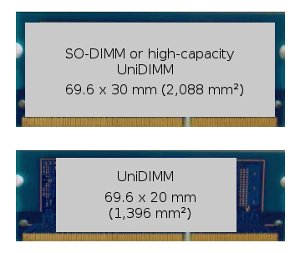Related Research Articles

Double Data Rate Synchronous Dynamic Random-Access Memory is a double data rate (DDR) synchronous dynamic random-access memory (SDRAM) class of memory integrated circuits used in computers. DDR SDRAM, also retroactively called DDR1 SDRAM, has been superseded by DDR2 SDRAM, DDR3 SDRAM, DDR4 SDRAM and DDR5 SDRAM. None of its successors are forward or backward compatible with DDR1 SDRAM, meaning DDR2, DDR3, DDR4 and DDR5 memory modules will not work on DDR1-equipped motherboards, and vice versa.

A motherboard is the main printed circuit board (PCB) in general-purpose computers and other expandable systems. It holds and allows communication between many of the crucial electronic components of a system, such as the central processing unit (CPU) and memory, and provides connectors for other peripherals. Unlike a backplane, a motherboard usually contains significant sub-systems, such as the central processor, the chipset's input/output and memory controllers, interface connectors, and other components integrated for general use.

A DIMM, or Dual In-Line Memory Module, is a popular type of memory module used in computers. It is a printed circuit board with one or both sides holding DRAM chips and pins. The vast majority of DIMMs are standardized through JEDEC standards, although there are proprietary DIMMs. DIMMs come in a variety of speeds and sizes, but generally are one of two lengths - PC which are 133.35 mm (5.25 in) and laptop (SO-DIMM) which are about half the size at 67.60 mm (2.66 in).

A SIMM is a type of memory module used in computers from the early 1980s to the early 2000s. It is a printed circuit board on which has random-access memory attached to one or both sides. It differs from a dual in-line memory module (DIMM), the most predominant form of memory module since the late 1990s, in that the contacts on a SIMM are redundant on both sides of the module. SIMMs were standardised under the JEDEC JESD-21C standard.

Double Data Rate 2 Synchronous Dynamic Random-Access Memory is a double data rate (DDR) synchronous dynamic random-access memory (SDRAM) interface. It is a JEDEC standard (JESD79-2); first published in September 2003. DDR2 succeeded the original DDR SDRAM specification, and was itself succeeded by DDR3 SDRAM in 2007. DDR2 DIMMs are neither forward compatible with DDR3 nor backward compatible with DDR.

Alienware Corporation is an American computer hardware subsidiary brand of Dell. Their product range is dedicated to gaming computers and accessories and can be identified by their alien-themed designs. Alienware was founded in 1996 by Nelson Gonzalez and Alex Aguila. The development of the company is also associated with Frank Azor (co-founder), Arthur Lewis, Joe Balerdi, and Michael S. Dell (CEO). The company's corporate headquarters is located in The Hammocks, Miami, Florida.
In the fields of digital electronics and computer hardware, multi-channel memory architecture is a technology that increases the data transfer rate between the DRAM memory and the memory controller by adding more channels of communication between them. Theoretically, this multiplies the data rate by exactly the number of channels present. Dual-channel memory employs two channels. The technique goes back as far as the 1960s having been used in IBM System/360 Model 91 and in CDC 6600.

Small form factor is a term used for desktop computers and for some of its components, chassis and motherboard, to indicate that they are designed in accordance with one of several standardized computer form factors intended to minimize the volume and footprint of a desktop computer compared to the standard ATX form factor.
In computing, serial presence detect (SPD) is a standardized way to automatically access information about a memory module. Earlier 72-pin SIMMs included five pins that provided five bits of parallel presence detect (PPD) data, but the 168-pin DIMM standard changed to a serial presence detect to encode more information.
Double Data Rate 3 Synchronous Dynamic Random-Access Memory is a type of synchronous dynamic random-access memory (SDRAM) with a high bandwidth interface, and has been in use since 2007. It is the higher-speed successor to DDR and DDR2 and predecessor to DDR4 synchronous dynamic random-access memory (SDRAM) chips. DDR3 SDRAM is neither forward nor backward compatible with any earlier type of random-access memory (RAM) because of different signaling voltages, timings, and other factors.

In computing, a memory module or RAM stick is a printed circuit board on which memory integrated circuits are mounted.
In computing, the motherboard form factor is the specification of a motherboard – the dimensions, power supply type, location of mounting holes, number of ports on the back panel, etc. Specifically, in the IBM PC compatible industry, standard form factors ensure that parts are interchangeable across competing vendors and generations of technology, while in enterprise computing, form factors ensure that server modules fit into existing rackmount systems. Traditionally, the most significant specification is for that of the motherboard, which generally dictates the overall size of the case. Small form factors have been developed and implemented.
Double Data Rate 4 Synchronous Dynamic Random-Access Memory is a type of synchronous dynamic random-access memory with a high bandwidth interface.

LGA 1151, also known as Socket H4, is a type of zero insertion force flip-chip land grid array (LGA) socket for Intel desktop processors which comes in two distinct versions: the first revision which supports both Intel's Skylake and Kaby Lake CPUs, and the second revision which supports Coffee Lake CPUs exclusively.

Double Data Rate 5 Synchronous Dynamic Random-Access Memory is a type of synchronous dynamic random-access memory. Compared to its predecessor DDR4 SDRAM, DDR5 was planned to reduce power consumption, while doubling bandwidth. The standard, originally targeted for 2018, was released on July 14, 2020.

UniDIMM is a specification for dual in-line memory modules (DIMMs), which are printed circuit boards (PCBs) designed to carry dynamic random-access memory (DRAM) chips. UniDIMMs can be populated with either DDR3 or DDR4 chips, with no support for any additional memory control logic; as a result, the computer's memory controller must support both DDR3 and DDR4 memory standards. The UniDIMM specification was created by Intel for its Skylake microarchitecture, whose integrated memory controller (IMC) supports both DDR3 and DDR4 memory technologies.

The ThinkPad P series line of workstation laptops produced by Lenovo and was introduced by the company as a successor to the previous ThinkPad W series. With 15.6" and 17.3" screens, the ThinkPad P series saw the reintroduction of physically large laptops into the ThinkPad line. Marketed largely as portable workstations, many P series laptops can be configured with high-end mobile workstation-class Intel processors as well as error correction code (ECC) memory and a discrete Nvidia Quadro GPU. The P series offers independent software vendor (ISV) certifications from software vendors such as Adobe and Autodesk for various computer-aided design (CAD) software. The P52 and P72 models are the last current Lenovo laptops with a dedicated magnesium structural frame.

LGA 1700 is a zero insertion force flip-chip land grid array (LGA) socket, compatible with Intel desktop processors Alder Lake and Raptor Lake, which was first released in November 2021.
Raptor Lake is Intel's codename for the 13th and 14th generations of Intel Core processors based on a hybrid architecture, utilizing Raptor Cove performance cores and Gracemont efficient cores. Like Alder Lake, Raptor Lake is fabricated using Intel's Intel 7 process. Raptor Lake features up to 24 cores and 32 threads and is socket compatible with Alder Lake systems. Like earlier generations, Raptor Lake processors also need accompanying chipsets.
References
- ↑ Ung, Gordon (2022-04-28). "Dell defends CAMM, its controversial new laptop memory". PCWorld. Retrieved 2023-04-19.
SO-DIMMs, which were first introduced almost 25 years ago, haven't changed much in all that time besides moving to newer and faster DRAM methods.
- ↑ Mueller, Scott (2004). Upgrading and Repairing Laptops. Que. ISBN 9780789728005.
- ↑ https://www.jedec.org/standards-documents/docs/module-444
- ↑ Norton, Peter; Clark, Scott H. (2002). Peter Norton's New Inside the PC. Sams. ISBN 9780672322891.
- ↑ Fulton, Jennifer (November 9, 2000). "The complete idiot's guide to upgrading and repairing PCs". Indianapolis, IN : Alpha Books – via Internet Archive.
- ↑ Solca, Bogdan. "SO-DIMM laptop RAM form-factor to soon be replaced with Dell-developed CAMM standard". Notebookcheck. Retrieved 2023-01-19.
- ↑ TechPowerUp - Dell's DDR5 CAMM Appears in More Detail, Comes in Several Shapes, Won't be Proprietary
- ↑ "Dell introduces CAMM DDR5 memory for its new Precision laptops, up to 128GB per module". VideoCardz.com. Retrieved 2023-01-19.
- ↑ Shilov, Anton (2023-06-01). "Adata Demos Next-Gen Memory: CAMM, CXL, and MR-DIMM Modules". Tom's Hardware. Retrieved 2023-07-25.
- ↑ "JEDEC Publishes New CAMM2 Memory Module Standard". jedec.org. Retrieved 2023-12-10.
- ↑ Klotz, Aaron (2024-05-07). "Lenovo ThinkPad P1 Gen 7 is the world's first laptop to sport LPCAMM2 memory — more compact, higher performance, lower power". Tom's Hardware. Retrieved 2024-05-08.
- ↑ Klotz, Aaron (2024-05-23). "MSI delivers first motherboard with CAMM2 memory — Z790 Project Zero brings new RAM standard to desktops". Tom's Hardware. Retrieved 2024-05-24.